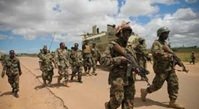
A new African Union (AU) peace support mission in Somalia started work on 1 January. This is the third consecutive mission in the country, and like its predecessors, funding for its operations remains uncertain.
The new AU Support and Stabilization Mission in Somalia (AUSSOM) replaced the AU Transition Mission in Somalia (ATMIS). Its mandate is to support the country in state building and degrade al-Shabaab and other terrorist groups.
Perennial funding challenges were intended to be addressed by drawing on a new mechanism that allows United Nations (UN)-assessed contributions from member states to cover 75% of the annual mission cost, with the AU making up the remaining 25%. This approach was agreed under UN Security Council (UNSC) Resolution 2719.
The UNSC’s December 2024 decision that set up AUSSOM (Resolution 2767) indicated the possibility of using this hybrid cost-sharing mechanism to fund the mission. But it set a six-month gap between the mission’s start and the application of the mechanism. The United States (US) had argued that, ‘the conditions have not been met for an immediate transition to the application of 2719 in Somalia.’
Hopefully, a UNSC meeting in May will resolve the issue by approving the new financial mechanism for AUSSOM.
Although funding is the mission’s biggest hurdle, it must also contend with political, operational and coordination challenges.
AUSSOM has been in the eye of a regional geopolitical storm. It was the subject of tension between Ethiopia – a major troop-contributing country for ATMIS – and Somalia over the memorandum of understanding signed between Addis Ababa and Somaliland, a self-declared independent state. Turkish mediation calmed the tension, creating conditions for Ethiopia’s possible participation in AUSSOM.
The mission started with all ATMIS’ troop- and-police contributing countries, except Burundi, which cited a discrepancy in troop allocation. Egypt may join as a new contributor, but a final agreement has yet to be reached on the mission’s composition.
Beyond these challenges, funding remains the most critical issue. During his 15 February AU summit address, UN Secretary-General António Guterres alluded to the uncertainty surrounding AUSSOM’s funding, stating, ‘We are urging for predictable funding for AUSSOM. I hope our voices will be heard by the Security Council.’
Past missions – the AU Mission in Somalia (AMISOM) and ATMIS – depended heavily on donor funding. The EU paid for troops’ stipends, while the UN provided logistical support packages to the missions and Somalia Security Forces through the UN Support Office in Somalia (UNSOS).
However, these funding channels were inadequate, unpredictable and unsustainable. Somalia struggled to make sufficient progress in state building, including adopting a new constitution and building viable security institutions. This, together with the funding uncertainty, contributed to both peace missions’ operational ineffectiveness, delays in troop stipends, and difficulties in maintaining control of areas liberated from al-Shabaab.
Similar concerns now confront AUSSOM. Despite the hard-won success of getting Resolution 2719 passed in December 2023, several hurdles prevent cash from flowing to AUSSOM. Access to the UN-assessed contributions depends on meeting certain milestones in the UN-AU Roadmap for operationalising Resolution 2719.
To resolve this, the UNSC is expected to vote on the final approval of the hybrid funding mechanism in May, following its review of two major UN Secretary-General reports.
Read the full article; Funding for Somalia’s new AU peace mission hangs in the balance
Source: ISS


Leave a Reply